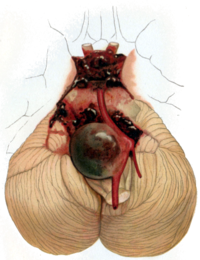
Photo from wikipedia
Background The pipeline embolization device (PED) is approved for the treatment of large aneurysms of the proximal internal carotid artery (ICA). Its off-label application in treating aneurysms located specifically at… Click to show full abstract
Background The pipeline embolization device (PED) is approved for the treatment of large aneurysms of the proximal internal carotid artery (ICA). Its off-label application in treating aneurysms located specifically at the ICA terminus (ICA-T) has not been studied. Methods We conducted a retrospective chart review of patients from 2011 to 7 treated with PEDs. Out of 365 patients, 10 patients with ICA-T aneurysms were included. Patient demographics, procedural information, follow-up imaging, and clinical assessments were recorded. Results Mean age was 46.9 years (± 8.8), and 6 (60%) patients were women. The mean maximum diameter of the aneurysms treated was 14.7 mm (± 10.7) and the mean neck diameter was 9.3 mm (± 6.6). Reasons for presentation included six incidental findings, one acute subarachnoid hemorrhage (SAH), and three patients with prior SAH. Kamran–Byrne Occlusion Scale scores for the treated aneurysms were as follows: three class IV (complete obliteration), four class III (<50% filling in both height and width for fusiform aneurysms or residual neck for saccular aneurysms), one class II fusiform aneurysm, 1 class 0 saccular aneurysm (residual aneurysm body), and one not classified due to pipeline thrombosis. Two clinically asymptomatic complications were noted: one patient who had a small distal cortical SAH post PED and one patient whose stent was found to be thrombosed on follow-up angiogram. All patients were seen in follow-up, and no patients were found to have worsening of their pre-procedure modified Rankin Scale score. Conclusion The PED has potential for treating ICA-T aneurysms not amenable to conventional treatment strategies. Further studies are warranted to confirm the long term outcomes.
Journal Title: Journal of NeuroInterventional Surgery
Year Published: 2018
Link to full text (if available)
Share on Social Media: Sign Up to like & get
recommendations!